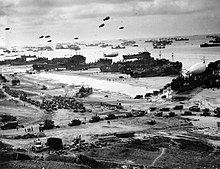Barrage balloon

A barrage balloon is a large balloon tethered with metal cables, used to defend against low-level aircraft attack by damaging the aircraft on collision with the cables, or at least making the attacker's approach more difficult. Some versions carried small explosive charges that would be pulled up against the aircraft to ensure its destruction. Barrage balloons were regularly employed only against low-flying aircraft, the weight of a longer cable making them impractical for higher altitudes.
World War II


In 1938 the British Balloon Command was established to protect cities and key targets such as industrial areas, ports and harbours. Balloons were intended to defend against dive bombers flying at heights up to 5,000 feet (1,500 m), forcing them to fly higher and into the range of concentrated anti-aircraft fire—anti-aircraft guns could not traverse fast enough to attack aircraft flying at low altitude and high speed. By the middle of 1940 there were 1,400 balloons, a third of them over the London area.
While dive-bombers were devastatingly effective against undefended targets, such as Guernica and Rotterdam, they were very vulnerable to attack by fighter aircraft, and their use by Germany against Britain with its effective Royal Air Force was rapidly discontinued. Balloons proved to be of little use against the German high-level bombers with which the dive-bombers were replaced, but continued to be manufactured nonetheless, until there were almost 3,000 in 1944. They proved to be mildly effective against the V-1 flying bomb, which usually flew at 2,000 feet (600 m) or lower but had wire-cutters on its wings to counter balloons. 231 V-1s are officially claimed to have been destroyed by balloons.[1]
Many bombers were equipped with devices to cut barrage balloon cables. Britain used large numbers of balloons, so Germany developed the most capable cable-cutters. Their systems consisted of small C-shaped devices attached to the leading edge of the wing. When a cable entered the device after sliding down the wing, it triggered a small explosive charge that drove a blade through the cable. British bombers were also equipped with cable-cutters although the Germans used few barrage balloons. [citation needed]
The British added two refinements to their balloons, "Double Parachute Link" (DPL) and "Double Parachute/Ripping" (DP/R). The former was triggered by the shock of an enemy bomber snagging the cable, causing that section of cable to be explosively released complete with parachutes at either end; the combined weight and drag bringing down the aircraft. The latter was intended to render the balloon safe if it broke free accidentally. The heavy mooring cable would separate at the balloon and fall to the ground under a parachute; at the same time a panel would be ripped away from the balloon causing it to deflate and fall independently to the ground.[2]
Disadvantages
Balloons were sometimes more trouble than they were worth. In 1942 Canadian and American forces began joint operations to protect the sensitive locks and shipping channel at Sault Ste. Marie along their common border among the Great Lakes against possible air attack.[3] During severe storms in August and October 1942 some barrage balloons broke loose, and the trailing cables short-circuited power lines, causing serious disruption to mining and manufacturing. In particular, the metals production vital to the war effort was disrupted. Canadian military historical records indicate that "The October incident, the most serious, caused an estimated loss of 400 tons of steel and 10 tons of ferro-alloys."
Following these incidents, new procedures were put in place, which included stowing the balloons during the winter months, with regular deployment exercises and a standby team on alert to deploy the balloons in case of attack. The idea of free-floating balloons was also used in Operation Outward.
Nuclear weapon tests
An unforeseen use for surplus barrage balloons was as tethered shot balloons for nuclear weapon tests, throughout most of the period when nuclear weapons were tested in the atmosphere. The weapon or shot was carried aloft to the required altitude slung underneath the barrage balloon, allowing test shots at much higher altitudes than tower shots, in controlled conditions. Several of the shots in the Operation Plumbob series were carried out using barrage balloons to carry the devices.
See also
References
- ^ "Barrage Balloons for Low-Level Air Defense". Air & Space Power Journal. Summer 1989. Retrieved 2007-04-16.
- ^ [1] RAF Museum online exhibition "Air Diagrams"
- ^ "Protecting Steel Lifeline / Barrage balloon goes aloft at Sault Ste. Marie, Mich., to protect Soo canal against possible air raids..." [photo caption], The Lima News [Lima, OH], 9 Apr. 1942, p. 3.
